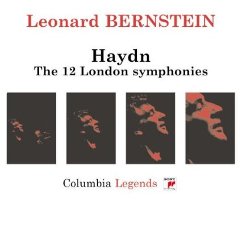Haydn - The 12 London Symphonies (Bernstein) CD2 [2003]
Haydn - The 12 London Symphonies (Bernstein) CD2 [2003]

CD 2 Symphony in D major, Hob.I No.96 "The Miracle" 1. Adagio, Allegro 2. Andante 3. Menuetto. Allegretto, Trio 4. Finale. Vivace (assai) Symphony in C major, Hob.I No.97 5. Adagio, Vivace 6. Adagio ma non troppo 7. Menuetto. Allegretto, Trio 8. Finale. Presto assai New York Philharmonic Leonard Bernstein – conductor
Supposedly, at the premiere of this work in London's Hanover Square Rooms in 1791, a chandelier crashed into the hall but didn't injure anyone because the audience had pressed forward to hear Haydn's new symphony. That's how the "Miracle" nickname arose, but it's attached to the wrong symphony; the "miracle" actually occurred during a performance of Symphony No. 102.
Symphony No. 96 opened the first "Haydn season" in London in March 1791, and the composer took pains to present himself as both a learned musician and a composer who could appeal to a wide, bourgeois audience (back in central Europe, he'd been playing to the courtly crowd). So this symphony begins with a brief Adagio, very serious yet neither heavy nor dramatic. This leads to the main Allegro matter with its mildly contrapuntal initial bars that burst into a resounding tutti. This music is busy, vibrant, and celebratory, full of sudden dynamic contrasts geared to keep the unpredictable English audience attentive. Of the 12 "Salomon" Symphonies, this has one of the more interesting development sections, working through the melodic fragments with greater thoroughness and variety than usual. Then after an unusual full stop comes the recapitulation, with a striking trumpet fanfare launching the coda.
The Andante varies a hesitant theme that consists of a brief ascending phrase, an equally brief descending answer, and a fairly long rumination on the terse exchange. Variety comes through orchestration rather than manipulation of the notes themselves, although the melody does sometimes benefit from a contrapuntal treatment. Otherwise, the guises range from the intimate to the pompous, with the former quality prevailing.
The Minuet alternates a brawny statement for full orchestra with a more delicate response for strings and woodwinds. As in the Andante, this answering phrase consists of short, hesitant utterances followed by a smoother, undulating passage. The trio features an oboe solo in a Ländler tune -- a light one, not given the buffoonish treatment that Haydn often prefers.
The finale, Vivace assai, offers one of Haydn's lighthearted, scampering tunes for strings with occasional woodwind doubling. Things remain at a low dynamic level until the first contrasting episode, which is derived from the main theme -- as will be each episode in this movement, which is a cross between rondo and sonata form. The music becomes boisterous only intermittently, including a brief minor-mode incident and the rousing if short conclusion. ---James Reel, Rovi
The first of Haydn's two excursions to London began in December of 1790 and was, by all accounts, a great success. He remained in London for two concert seasons, returning to Vienna in July 1792. The composer wrote six new symphonies for the concert series; these are now numbered 93-98, the first six of the so-called "London" symphonies.
Despite its numbering, Haydn's Symphony No. 97 in C major (H. I:97) was the last of the six initial "London" symphonies he composed. It was first performed on May 3, 1792, in London.
It is the last in a long line of brilliant, festive "trumpet and drum" symphonies in C major. March-like rhythms and fanfare-like motives imbue the first movement with a martial atmosphere. Haydn creates a link between the first movement's slow introduction and the ensuing sonata-form structure by using the cadence from the beginning and end of the introduction to close the exposition, unifying what in other ways are decidedly disparate sections of the piece.
The slow movement, marked Adagio ma non troppo, is a set of variations in which subtle orchestral effects contribute as much to the variants of the theme as do changes in melodic shape and harmonic background.
Subtle alterations in orchestration are also a feature of the Minuet and Trio, in which none of the repeats is literal, allowing for changes in instrumentation and texture while following the traditional pattern of repetition characteristic of the minuet. Haydn's Allegretto tempo keeps the movement in the realm of the minuet as opposed to the quicker scherzo. At the close of the trio is a violin solo with the direction, "Salomon solo ma piano," most likely a gesture of thanks to the impresario who was responsible for the most fulfilling musical and professional experience of the composer's life. The isolation of this single line from the rest of the orchestra, supported by an "oom-pah-pah" accompaniment in the timpani and horns (an unusual use of tone color for the time), as well as the leaping grace notes in the horns and violins on downbeats, are evidence of Haydn's mastery of orchestration.
An amalgam of sonata and rondo forms, the Finale was originally marked Spirituoso, but after his arrival in Vienna in 1792, Haydn changed the direction to Presto assai. Section A is repeated and moves to the dominant, G major. Section B takes up the new key with horns pounding away on G naturals. After a few measures this stark accompaniment shifts to the trumpets and timpani -- another case of unusual scoring. A reference to the "A" theme rounds off section B, which ends on the tonic and is repeated. The central section contains not only new material, but developmental passages based on themes from the first two sections, after which both A and B return in their original forms without repeats. Because section B in its original form ends on C major, there is no reason for any modification at its reprise, but the ensuing coda's further confirmation of the tonic is necessary as the movement closes with snippets of the A theme. ---John Palmer, Rovi
download (mp3 @320 kbs):
yandex 4shared mega mediafire cloudmailru uplea








